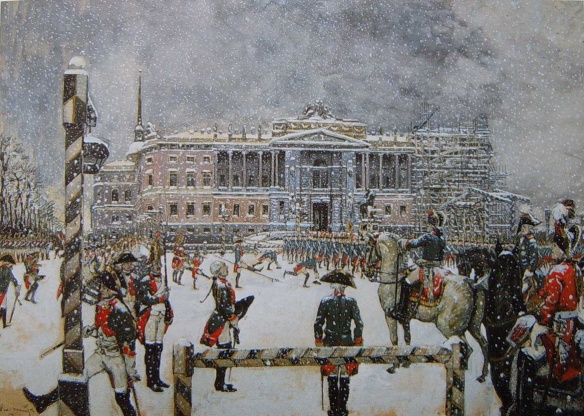Military Parade of Emperor Paul in front of Mikhailovsky Castle painting by Alexandre Benois, taken from the art book World of Art.
In the year of the foundation of Odessa, Catherine was succeeded by her son Paul, whose ambitions easily outstripped those of his mother, for she had been clever enough to know the limits of Russian power. He had already travelled to the Mediterranean in 1782, notionally incognito as ‘the count of the North’, on a grand tour that encompassed Naples, Venice and Genoa, and his experiences aroused his interest in establishing a Russian foothold in the region. In his short five-year reign he once more propelled Russia into the heart of the Mediterranean. The Russians still sought an island base in the Mediterranean; but Tsar Paul’s attention wandered eastwards from Minorca, and focused instead on Malta. Yet, as before, it was circumstances far from the Mediterranean that prompted Russian intervention, and Paul’s initial interest lay not in the island but in its Knights. Links between the Knights of Malta and Russia went back many years. Peter the Great had sent his general Boris Cheremetov to the island in 1697, to propose a joint campaign against the Ottomans. Russian ships would engage the Turkish navy in the Black Sea, while the small but potent Maltese fleet would attack the Turks in the Aegean. The Grand Master was not willing to throw in his lot with the still little-known Russian empire, which remained, after all, the bastion of Orthodox Christianity. Still, Cheremetov greatly impressed the Knights by his tearful devotion to the relic of the arm of St John the Baptist, brought into the magnificent Conventual Church in Valletta during the service for Pentecost, which was attended, to the great fascination of the Knights, by this visitor from another Christian world.
Under Catherine, too, there were matters arising between the Knights and the Russian court. These turned on a complex legacy by a Polish nobleman which resulted in the establishment of a Hospitaller priory in Russian-controlled areas of Poland. Catherine imagined that she could use the Knights against her opponents in Poland, and welcomed an old acquaintance, Michele Sagromoso, an Italian Knight of Malta, to her court in 1769, aware that he brought messages from the Grand Master and from the pope, who, naturally, was keen to set up Catholic institutions in the Russian empire. Religious questions intruded, however, when Catherine sent a dubious Italian protégé, the burlesque marquis of Cavalcabó, to Malta as her agent. Things did not start well: the Knights objected to the presence of a chargé d’affaires appointed by a non-Catholic power, and Cavalcabó was an untrustworthy figure who was suspected of conspiring with the strong pro-French party among the Knights. For many of the Knights were French, and the Order of Malta held vast estates in France. Cavalcabó’s aim was to gain access to Malta for the Russian fleet, which at this stage was still wandering the eastern Mediterranean. By 1775 the frustrated imperial agent was scheming with the ancient Maltese nobility, who had long been pushed to the margins by the Knights, in the vain hope that they would lead an uprising against their tyrannical masters and confer their island on Empress Catherine. The Knights became increasingly irritated at the bizarre behaviour of Catherine’s agent. They raided his house in Floriana, the suburb of Valletta, only to find it full of arms. Cavalcabó was kicked out, and he spent his last days in disgrace, living in France in fear of arrest for fraud.
Tsar Paul’s approaches to the Knights of Malta were not, then, a total surprise. Paul had studied the history of the Knights as a young man, and he romantically saw the Order as a potential bulwark against revolution: here were noblemen of pure blood, united by common Christian zeal, transcending the petty differences between the European states of his day. He was unworried by its Catholic identity, and never had any doubt that he, as the greatest Orthodox prince, could work closely with the Order. He imagined that the Knights of Malta would be able to support him on two fronts: a Polish-Russian priory would contribute money and manpower to the fight against the Turks in mainland eastern Europe, while the Knights based in Malta, working together with Russian squadrons, would squeeze the Turks in the Mediterranean. Before long, Orthodox rule would be restored in the old Byzantine lands. There was one insuperable obstacle to this grand dream. The name of this obstacle was Napoleon Bonaparte.
